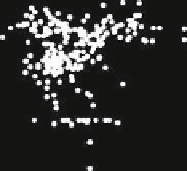Environmental Engineering Reference
In-Depth Information
100
10
10
1
1
0.1
0.1
0.01
0.01
0.001
0.10
1.00
10.0
100
1
10
100
1000
Total soil Cd
(mg Cd/kg)
Total soil Pb (mg Pb/kg)
Fig. 8.7
Data of Dutch and Belgian surveys of metal concentration in field grown maize (whole
shoots). Concentrations in maize generally correlate better with soil metal concentrations for cad-
mium (
left
) than for lead (
right
); lead concentrations in arial parts are often more reflecting air
concentrations rather than soil concentrations, i.e. atmospheric contribution is larger than soil con-
tribution in the case of cadmium. Data collated by Jansson et al. (
2007
) and Römkens and Rietra
(unpublished)
Hovmand et al. (
1983
) used the isotope dilution method and bulk precipitation data
to show that up to 70% of deposited cadmium could be incorporated in field-grown
carrots, but the authors acknowledged that airborne submicron-sized particles con-
taining cadmium, not sampled via the bulk precipitation, could also be filtered out
by plant surfaces. Such interpretation suggests that AAF values may be a more suit-
able basis for modeling the transfer of metals and metalloids from air to plant. The
AAF values observed by Harrison and Chirgawi (
1989
) ranged from 2 to 40 m
3
/g
for different plants and metals, typically about 10 m
3
/g. Field-based estimates, using
isotopically labeled soils, have yielded values that sometimes exceed 100 m
3
/g for
plant leaves (values for cadmium based on Hovmand et al.
1983
). The AAF values
are obviously not metal-specific values, but depend on plant type, aerosol properties,
climatic factors, et cetera.
The above-mentioned data are at least 15 years old and there are little recent data
measured under current atmospheric air quality, which typically demonstrates lower
air metal concentrations in recent years due to environmental regulations (e.g. the
ban on leaded gasoline). A simple sensitivity analysis allows modeling of the cur-
rent atmospheric contribution, using the experimentally determined AAF and BCF
values, the latter observed in 'clean air'. As shown in Table
8.7
, we predict that still
50% of lead present in lettuce leaves in rural areas is derived from the atmosphere.
A quantification of the pathway by which metals or metalloids enter the plant, i.e. by
air or soil, has obvious consequences for Risk Assessment. For example, it is gen-
erally known that managing food chain contamination by metals could be achieved
by managing air contamination for lead and, conversely, soil contamination for cad-
mium. However, the analysis in Table
8.7
suggest that human exposure to cadmium
around smelters in the past, with cadmium concentrations in air often exceeding
100 ng/m
3
, could have predominantly originated from atmospheric contributions to
plants.









































































Search WWH ::

Custom Search